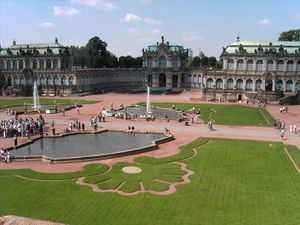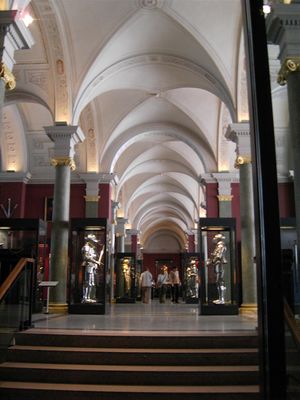Mathematisch-Physikalischer Salon/en: Unterschied zwischen den Versionen
| Zeile 27: | Zeile 27: | ||
== Directors == | == Directors == | ||
| − | *Johann Gottfried Köhler until 1801 | + | *[[Johann Gottfried Köhler]] until 1801 |
| − | *Johann Heinrich Seyffert from 1801 | + | *[[Johann Heinrich Seyffert]] from 1801 |
== Inspectors == | == Inspectors == | ||
Version vom 9. Februar 2009, 20:28 Uhr
Mathematisch-Physikalischer Salon
| other languages: de |
The Mathematisch-Physikalischer Salon in Dresden, Germany, is a museum of the Staatliche Kunstsammlung Dresden (governmental collection of art Dresden). It accommodates on of the most significant collections of around 2,000 clocks and fine mechanical instruments. Some of the collection’s highlights are the Arabian celestial globe of 1279, a calculating machine of around 1650 once belonging to Blaise Pascal and the orbit clock manufactured in the 1560ies by order of the court of Dresden.
History of the Mathematisch-Physikalischer Salon
The roots of the Mathematisch-Physikalischer Salon go back to the 15th century. Albrecht der Beherzigte (Albrecht the heartily) established the Herzoglische Harnischkammer (ducal armour chamber) at the Duke’s residence in Dresden. Later it turned to be the Kurfürstliche Rüst- und Harnischkammer (electoral munition and armour chamber). It was used for storing the personal, tournament and parade weapons and associated equipment of the court.
Elector August of Saxony started to purposefully collect objects of art and for a part stored them in the munition and armour chamber. Already in the 16th century the collection reached a similar volume than the one of the imperial armoury in Vienna. The elector combined the Kurfürstliche Rüst- und Harnischkammer and the Jagdkammer (hunting chamber) to the Kurfürstliche Rüstkammer (electorial munition chamber).
In 1724 the mathematical and physical instruments were separated from the munition chamber and other collections of the elector and stored in the new founded “Königliches Cabinet der mathematischen und physikalischen Instrumente” (royal cabinet of mathematical and physical instruments). Until 1746 this was the official name of the collection. The collection concentrated on instruments measuring the length, temperature, weight, volume and time. Since 1728 the royal cabinet can be found in the Zwinger. The first residence of the cabinet was the pavilion of the carillon in the Dresden Zwinger. In 1746 the collection was replaced in a part of the building which is today called pavilion F, and stayed there until today. Since that time it is called the Mathematisch-Physikalischer Salon.
In 1784 the observatory was founded at the Mathematisch-Physikalischer Salon.
Today, the Mathematisch-Physikalischer Salon in Dresden is one of the most famous collections of clocks and geodetic instruments. The museum of sciences was closed at the end of 2006 due to a general reconstruction of the Zwinger. Its reopening is planed for 2009. From May 4, 2007 on a part of the collection is shown in the castle “Moritzburg”. From Mai 16 to September 2, 2007 a special exhibition “Geometrie der Macht” (geometry of power) in the castle of Dresden showed amongst others sun dials, orbit clocks, astrolabes and instruments for encryption.
Library of the Mathematisch-Physikalischer Salon
The electoral library (later the regional library of Saxony) was founded in 1556. In connection to the foundation of the Königliches Cabinet der mathematischen und physikalischen Instrumente first of all special scriptures corresponding to the objects of the collection were stored. Additionally, some standard works to the topics of the collection and similar topics were bought. In connection with the foundation of the observatory at the Mathematisch-Physikalischer Salon in 1784 the history of astronomy and their corresponding scientific instruments were the main focus for the further improvement of the library. During the mid of the 19th century, purposeful purchase of literature led to a continuous enlargement of the library. Also, for the topics history of time measurement, calculation machines and optical and physical instruments the inventory of literature was enlarged. Additionally, a lot of donations add to the today’s amount of literature.
Worldwar II did not stop in front of the collection and the library of the Mathematisch-Physikalischer Salon. Many objects and scriptures were sourced out in castles and manors of the Third Reich. Precious prints from the older inventory of the library were lost. After the reconstruction of the Zwinger at the beginning of the 1950ies also the library went back to their old residence in Dresden Zwinger.
Instantly, the inventory of the library contains 896 monographs from which 25 are from the 17th century. 91 monographs are from the 18th century and 779 from the 19th century.
Directors
- Johann Gottfried Köhler until 1801
- Johann Heinrich Seyffert from 1801
Inspectors
- Wilhelm Gotthelf Lohrmann (chief inspector from 1827)
Literature
- Taschenuhren und Seechronometer deutscher, österreichischer und englischer Meister: catalogue of collection / Staatlicher Mathematisch-Physikalischer Salon Dresden; author: Klaus & Jochim Schardin; ISBN 300002073X
- Uhren - Globen - wissenschaftliche Instrumente Mathematisch-Physikalischer Salon Dresden-Zwinger, exhibition guide (1993); Karl M. Lipp Verlag, Dresden
- Handbuch der historischen Buchbestände in Deutschland.
Address
Zwinger
Sophienstraße
01067 Innere Altstadt Dresden (showing this place)
Secretary
Tel : + 49 (0)351 4914 6661
Fax: + 49 (0)351 4914 6666
E-Mail: [email protected]

